Top Stories
IDF said to raid Syrian army site near Damascus with helicopters, ground troops
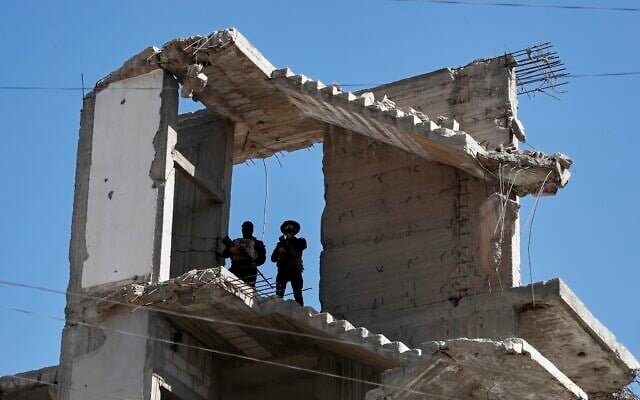
Israeli ground troops conducted a commando raid overnight Wednesday-Thursday on a Syrian site it had already bombed on the two previous days, Syrian state media reported, in a major operation said to have included helicopters and fighter jets as well as dozens of ground troops.
Israel first struck the site outside Damascus on Tuesday, killing several Syrian soldiers, according to Damascus’s foreign ministry, and bombed it again on Wednesday, according to state television.
A Syrian defense ministry official told AFP on condition of anonymity that the site was a former Syrian military base in Tal Maneh, near Kisweh.
Following the second attack on Wednesday, state media said that Israeli troops were flown into the area to carry out a raid, “the details of which are not yet known, amid continued intensive reconnaissance flights.”
According to two Syrian army sources, a unit of the Israeli army carried out an airborne landing on a strategic hilltop southwest of Damascus and conducted a two-hour operation before leaving the area.
They said the troops landed near Jabal Manea, which was once a major air defense base operated by Iran before being destroyed by Israel after the fall of Bashar al-Assad’s regime.
Illustrative: Syrian security officers stand guard in a war-damaged building during a gathering to mark the anniversary of the 2013 chemical weapons attack by former president Bashar Assad’s forces, in Zamalka on the outskirts of Damascus, Syria, August 21, 2025. (AP Photo/Omar Sanadiki)
A number of troops from the new Syrian army are positioned at the base, the sources said.
According to a Syrian source who spoke to Al Jazeera, the raid involved four helicopters and two fighter jets, as well as dozens of soldiers.
The Britain-based Syrian Observatory for Human Rights, which relies on a network of sources on the ground, reported that the site had weapons used by the Iran-backed Lebanese terror group Hezbollah, a major ally of former Syrian ruler Assad.
The Observatory said the Israeli ground raid was the first of its kind since the fall of Assad in an Islamist-led rebel offensive in December.
The increased Israeli military activity in Syria comes as the two countries are engaged in “advanced” US-mediated talks on easing tensions in southern Syria, with Damascus seeking a security deal that could open the door to wider political negotiations.
According to Hebrew media reports earlier this week, Damascus and Jerusalem are closing in on understandings, and the deal in discussion would be based on the disengagement lines that the two sides agreed to in 1974 after the Yom Kippur War a year earlier.
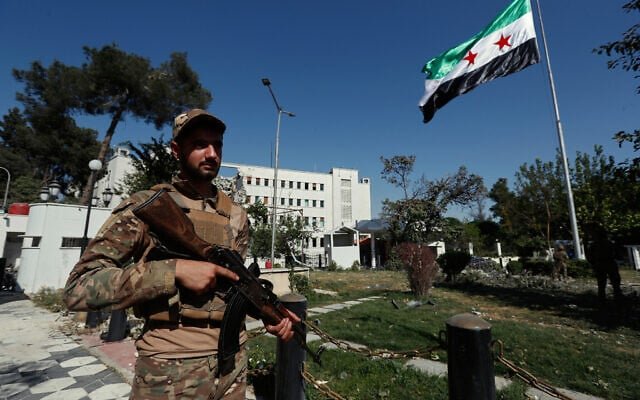
Illustrative: Syrian soldiers raise the Syrian national flag in front of the Syrian Defense Ministry building, which was heavily damaged by Israeli airstrikes, in Damascus, Syria, July 19, 2025. (AP Photo/Omar Sanadiki)
After the reports of Wednesday night’s raid, Defense Minister Israel Katz declared Thursday morning on X that Israeli forces “are operating on all battle fronts day and night for the security of Israel.”
He did not indicate what he was referring to, though the post came minutes after Syrian media reported the commando raid.
Asked for comment, an Israeli military spokesperson said: “We do not comment on foreign reports.”
Israel’s strikes on Tuesday had reportedly targeted Syrian soldiers who, while on patrol, discovered “surveillance and eavesdropping devices” reportedly belonging to Israel.
Syrian state media said that additional Israeli strikes prevented other troops from reaching the area until Wednesday evening, when other soldiers were able to retrieve the bodies of the soldiers killed the day before, and “destroy some of the (surveillance) systems by targeting them with the appropriate weapons.”
The Syrian government on Wednesday condemned “the recent Israeli attacks on its territory,” but had yet to comment on the reported Israeli ground raid.
It also condemned what it said was an incursion on Monday by IDF soldiers into a town in the Quneitra countryside, their “arrest campaigns against civilians,” and their “announcement of the continuation of their illegal presence on the summit of Mount Hermon and the buffer zone.”
“These aggressive practices constitute a flagrant violation of the UN Charter, international law, and relevant Security Council resolutions, and constitute a direct threat to peace and security in the region,” Damascus added.
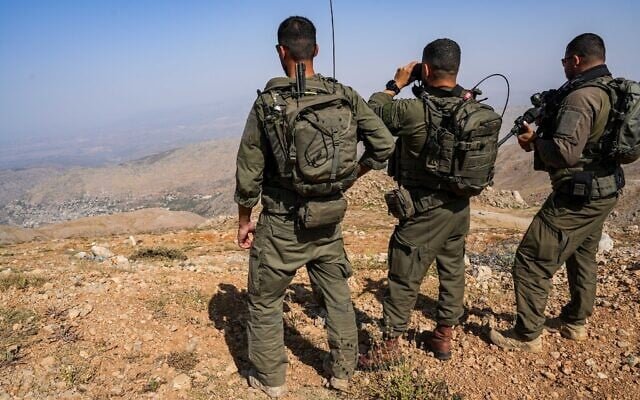
Israeli soldiers operate on the Syrian side of Mount Hermon, August 12, 2025. (Ayal Margolin/Flash90)
‘Fake news’
Meanwhile, Prime Minister Benjamin Netanyahu’s office on Thursday denied as “fake news” a report by the Kan public broadcaster that Israel seriously considered transferring the Mount Dov area in exchange for Syria giving up its claim to the Golan Heights in security talks with Damascus a few weeks ago.
“The claim that Israel supposedly considered handing over Mount Dov is absolute fake news,” the PMO said in response to the report.
According to Kan, Israel examined the ceding Mount Dov, also known as Shebaa Farms — strategic high ground captured along with the Golan Heights in the 1967 Six Day War — in return for Damascus suspending its sovereignty claim to the Golan.
The report said officials explored the “political feasibility” of the move, which would require approval from 80 Knesset members, during talks that were suspended following sectarian violence in Syria’s southern Sweida province last month.
The report noted that Syrian President Ahmad al-Sharaa told Arab journalists this week that Damascus cannot join the Abraham Accords while the Golan remains under Israeli control. At the same time, Sharaa confirmed that his government is in “advanced” talks with Israel to pursue a security deal based on the 1974 UN-brokered disengagement lines, which created a ceasefire zone between Israeli- and Syrian-held territory on the Golan Heights.
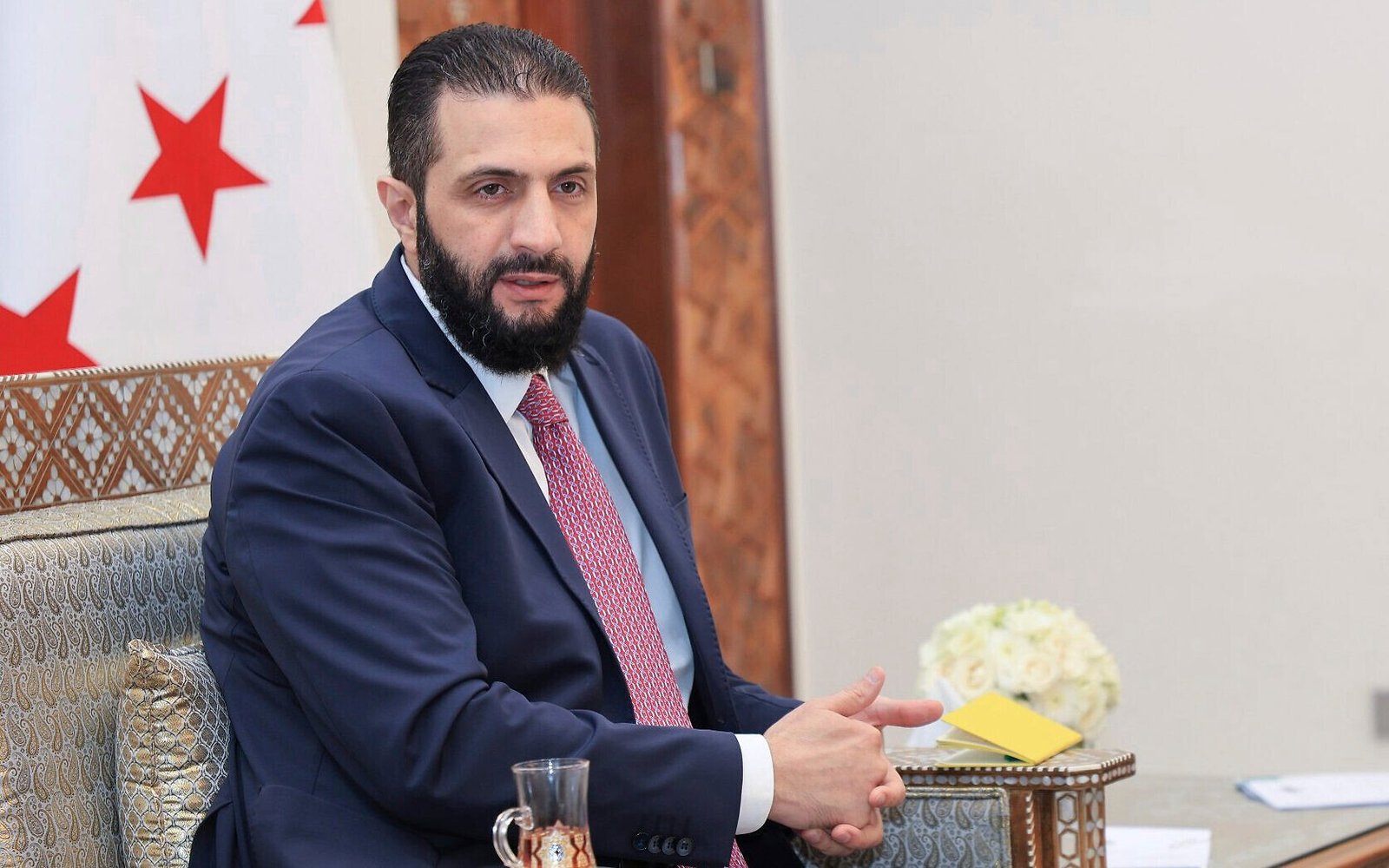
In this photo released by the Syrian official news agency SANA, Syria’s President Ahmad al-Sharaa receives the final version of the provisional electoral system for the people’s assembly, in Damascus, Syria, July 27, 2025. (SANA via AP)
The IDF has been deployed at nine posts inside southern Syria since the fall of the Assad regime in December 2024, mostly within a UN-patrolled buffer zone on the border between the countries.
Israeli forces have been operating in areas up to 15 kilometers (some nine miles) deep into Syria, including Beit Jinn, aiming to capture weapons that Israel says could pose a threat to the country if they fall into the hands of hostile forces.
Amid ongoing US-mediated talks between Israel and Syria, Katz vowed Tuesday that IDF troops would remain in Syria to defend the north, saying Israel’s need to maintain a presence there is a “central lesson from the events of October 7.”
Top Stories
Craig Jones puts Chael Sonnen to sleep twice in CJI 2 superfight

Chael Sonnen stepped in as a late replacement for Gable Steveson at Sunday night’s Craig Jones Invitational 2 in Las Vegas and did his best to survive against Craig Jones.
In a match scheduled for three five-minute rounds, Sonnen managed to get tapped twice with the same move.
A former UFC middleweight and light heavyweight title challenger, Sonnen immediately took Jones to the ground to find himself locked in a buggy choke. The choke was tight, and Sonnen apparently went to sleep.
Sonnen regained his senses, and both athletes agreed to go at it again. Sonnen took Jones down again, going for a leg lock with no real danger to a grappler of Jones’ caliber. The CJI founder against attacked with the buggy choke, again having Sonnen go lights out.
McCarthy couldn’t help but laugh as Sonnen tried to make it best three out of five — and the crowd chanted to get the two go at it again —, but the referee called the end of the contest.
The official result was read as Jones being victorious via double buggy choke.
Watch the second finish below.
Top Stories
Liverpool agrees to British-record deal for Alexander Isak, sources say

Liverpool have agreed to a British-record deal to sign striker Alexander Isak from Newcastle United, sources told ESPN.
The Premier League champions have had a £125M bid accepted to sign the Sweden international, who is expected to undergo a medical ahead of Monday’s transfer deadline.
It brings an end to one of the summer’s most-protracted transfer sagas, with Isak having spent more than a month agitating for a move away from Newcastle. The 25-year-old did not join the club on their preseason tour of the Far East and has not featured for Eddie Howe’s side this season.
He also released a sensational statement earlier this month in which he claimed promises had been “broken” by the Newcastle hierarchy and insisted a move this summer would be in the best interests of all parties.
Isak is now set to become the most expensive signing in Premier League history, surpassing Chelsea’s Moisés Caicedo who joined the London club for £115M from Brighton & Hove Albion in the summer of 2023. It marks the second time this summer that Liverpool have broken their transfer record, with Arne Slot’s side having committed spending an initial £100M (plus a potential £16M in add-ons) to sign Florian Wirtz from Bayer Leverkusen in June.
Top Stories
Donald Trump as the wildcard and other takeaways for India-China relationship

Vikas PandeyIndia editor and
Stephen McdonellChina correspondent
 Reuters
ReutersThe view from India
Just a few months ago, the armed forces of India and Pakistan were locked in a brief but deadly conflict.
The conflict indirectly involved a third nation – China. Pakistan’s armed forces heavily used China-made equipment, including fighter jets and radar systems.
A senior army officer in Delhi said Beijing also provided “live inputs” to Pakistan on Indian positions.
India didn’t take a public stand against China, but this left many asking if Delhi should continue on the path of normalising relations with Beijing.
Less than six months later, peace talks between the two Asian giants have been turbocharged by decisions taken thousands of miles away in Washington DC.
The Trump administration has imposed 50% tariffs on Indian imports, saying Delhi was being punished for its refusal to stop buying oil from Russia.
Delhi had two clear choices after this stunning onslaught from a trusted ally.
The first was to cave in and stop buying Russian oil. But it has refused to do so, largely because Russia is an “all-weather” ally and giving into pressure doesn’t suit Indian Prime Minister Narendra Modi’s strongman image.
The second was to stand firm and seek other opportunities and India appears to have to chosen this option for now.
It’s also pragmatic to look no further when your neighbour is the world’s second-largest economy and a global manufacturing powerhouse.
It was in this context, that Modi met Chinese President Xi Jinping in Tianjin over the weekend.
Statements from the two sides were not heavy on details, though they promised to work through their differences to benefit their collective population of 2.8 billion people.
The immediate takeaway from the meeting was the resumption of direct flights between the two countries and making the process of issuing visas simpler.
But beyond the promise of “the elephant and the dragon” coming together, the two countries still have major roadblocks to clear before they are able to engage meaningfully.
Their first challenge comes from their immediate history.
Modi has invested personally in the India-China relationship since coming to power in 2014, visiting the neighbouring country five times until 2018.
But the 2020 border clash put brakes on this momentum and it has taken seven long years for Modi to visit China again.
The key to making further progress will depend on how the two countries deal with their border issues.
Tens of thousands of troops from both countries are still deployed at their contested borders – though there are ongoing talks between their civilian and military leaders to ease the situation.
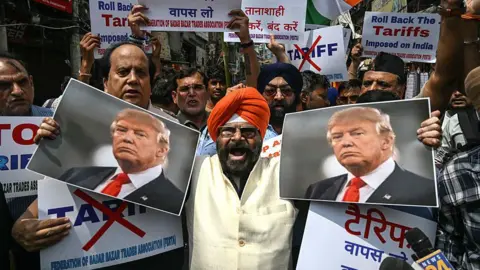 AFP via Getty Images
AFP via Getty ImagesBoth Chinese and Indian readouts after the meeting this weekend talked about maintaining peace at the border and “not turning their differences into disputes”.
For India, there is the issue of a burgeoning trade deficit with China, amounting to more than $99bn (£73bn).
Both countries still have high tariffs and duties against each other in many sectors.
Beijing would want India to open its market of 1.4 billion people to Chinese products, but Delhi would be wary of doing that without addressing the deficit.
The outreach to China, which started with Modi meeting Xi in Kazan last year, may have been supercharged by Trump tariffs, but ground realities for India remain unchanged.
The Modi-Xi meeting is being seen as part of India’s policy of “strategic autonomy” but it will also cause more geopolitical challenges for Delhi.
India is due to host the Quad (which includes Japan, Australia and the US) summit later this year. The forum was largely seen as a challenge to China’s dominance in the Indo-Pacific region.
It’s not clear if Trump will attend, but if he does and says something against China, it will immediately test the renewed synergy between Delhi and Beijing.
Delhi is also part of several other multilateral forums that are perceived as anti-China and anti-Russia.
How Delhi plays its strategic autonomy in the next few months will very much influence the direction India-China ties take.
For now, it’s clear that India-US ties are at an all-time low. A Trump aide recently called the Russia-Ukraine conflict “Modi’s war”.
Delhi has also consistently denied that Trump played any role in the ceasefire between India and Pakistan in May – this has become a constant irritant for the US president.
Despite this, India has refrained from imposing retaliatory tariffs against the US and has left the door ajar for further negotiations. After all, the US is India’s biggest trading partner.
Will going closer to China help India’s negotiations with the US or will it have the opposite impact?
This is the question that will likely dominate geopolitical discussions in Delhi and beyond in the coming months.
 Hindustan Times via Getty Images
Hindustan Times via Getty ImagesThe view from China
When Xi Jinping met Narendra Modi he used what has become his favourite catchphrase for China-India relations: “The dragon and the elephant should come together”.
During “this period of transformation,” he added that it was vital for the world’s most populous nations to be friends and good neighbours.
In a case of spectacular timing, Prime Minister Modi’s visit has coincided with Donald Trump’s tariffs of up to 50% on India exports to the US.
This represents quite a hit on the country’s economy so New Delhi would be looking around for other business partners.
Look no further than right here, Xi may well say, as his administration attempts to rebuild from the wreckage of China-India relations following years of tension between the two.
And, if their official readouts are anything to go by, Modi’s attendance at the Tianjin Summit of the Shanghai Cooperation Organisation seems to have paid off.
His published comments to Xi were much more specific than the those coming the other way.
There is now a very good window for Beijing and New Delhi to repair their strained relationship.
China’s leader knows that Donald Trump’s tariff onslaught is pushing India away from the United States and that this great economic rival needs other partnerships.
Considerable obstacles remain.
They include China’s backing of India’s key rival Pakistan; interaction of all types has been in the doldrums; angry rhetoric from both governments (over many years) has created a climate of suspicion between the Asian heavyweights and their high-mountain border dispute has stirred nationalist sentiment on both sides of the frontier.
However, with the latter of these, this meeting would appear to confirm that pressure has already eased.
Last Thursday China’s Defence Ministry spokesman was talking up the success of discussions between the representatives of China and India aimed at stopping the clashes along their disputed border.
He spoke of “win-win cooperation” and celebrating the 75th anniversary of ties between the two nations.
Xi also knows that the symbolism of having Modi in China right now is considerable, that images of them shaking hands and standing side-by-by side – as the Trump tariffs on India kick in – can be a powerful propaganda tool which is made even more significant by the fact that this is a multilateral gathering.
The two will not only be joined by Vladimir Putin but by the other SCO governments like Turkey (a member of Nato), Saudi Arabia (a key US ally), Iran (a key enemy of the US) as well as Qatar, Egypt and Pakistan.
And all of this in the days before Beijing holds a massive display of military might with a parade through the heart of the capital.
-
Tools & Platforms3 weeks ago
Building Trust in Military AI Starts with Opening the Black Box – War on the Rocks
-

 Business3 days ago
Business3 days agoThe Guardian view on Trump and the Fed: independence is no substitute for accountability | Editorial
-

 Ethics & Policy1 month ago
Ethics & Policy1 month agoSDAIA Supports Saudi Arabia’s Leadership in Shaping Global AI Ethics, Policy, and Research – وكالة الأنباء السعودية
-

 Events & Conferences3 months ago
Events & Conferences3 months agoJourney to 1000 models: Scaling Instagram’s recommendation system
-

 Jobs & Careers2 months ago
Jobs & Careers2 months agoMumbai-based Perplexity Alternative Has 60k+ Users Without Funding
-

 Funding & Business2 months ago
Funding & Business2 months agoKayak and Expedia race to build AI travel agents that turn social posts into itineraries
-

 Education2 months ago
Education2 months agoVEX Robotics launches AI-powered classroom robotics system
-

 Podcasts & Talks2 months ago
Podcasts & Talks2 months agoHappy 4th of July! 🎆 Made with Veo 3 in Gemini
-

 Podcasts & Talks2 months ago
Podcasts & Talks2 months agoOpenAI 🤝 @teamganassi
-

 Mergers & Acquisitions2 months ago
Mergers & Acquisitions2 months agoDonald Trump suggests US government review subsidies to Elon Musk’s companies


